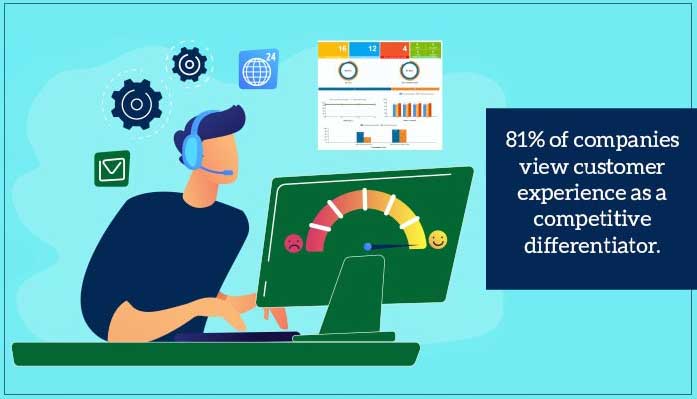81% of companies view customer experience as a competitive differentiator!
In today’s world, customer experience is key for brands, and the frontline plays a significant role. A whopping 90% of Americans consider customer experience as a primary factor in deciding whether or not to do business with an organization. Hence, it should be one of the highest priorities for companies to adopt the best practices to focus on customer retention and manage effective interactions.
Is your brand doing the right thing?
Whether your company has an internal contact center or has outsourced the customer experience to a contact center, quality monitoring has a significance in both scenarios. Quality monitoring enables data scientists, contact center managers, and technologies to work together to easily spot and discover problems within the teams by effectively monitoring the interactions between the agents and customers. Once more, they are also able to improve quality standards, ensure compliance, boost customer experience, and improve the overall performance of the brand.
However, monitoring is often being seen as an invasive top-down process put in place by management to micromanage agents. In reality, it is an integral part of a contact center to increase customer retention levels and quality service. So, we should push quality monitoring out of its shadow and give it the importance that it deserves.
Here’s how the best quality monitoring practices create a remarkable difference:
1. Conversion of Raw Data into Measurable Results
An ideal contact center quality monitoring program should be able to gain invaluable insight into what makes a remarkable consumer experience. The most valuable results for contact centers should come from quality monitoring data because it’s easy to measure the tangible metrics and can be immediately improved as well.
Also, quality management should serve as the foundation to set evaluation standards for scorecards, coaching for leaders and team members, as well as providing insights for management to improve contact center processes and ensure continuous quality customer experience.
2. Recording and Analyzing Calls
The quality assurance managers should have enough data from which they can draw valuable insights. It’s imperative to follow a strategic approach when selecting the calls to monitor for quality assurance and training purposes. Though it is not feasible to monitor each customer interaction manually, choosing a random sample of calls will not provide accurate data or an idea of the team members’ performance either.
Here, the speech analytics systems which records all of the calls and monitors call-quality in real-time can be an effective solution to get a comprehensive view of calls and improve the customer experience. With this technology in place, it is possible to unlock insights as it allows managers to understand the behavior of top performers compared to the stragglers. The insights can be useful to build strategies for coaching team members towards providing first call resolution with higher levels of customer satisfaction.
3. Not Too Much Emphasis on Contact center Metrics
It’s not recommended to focus too much on metrics like average handle time because it doesn’t always assure good results. If a call is closed in a hurry to attend the next caller in the queue, the call quality gets hampered, and it may also lead to an increase in repeat calls and frustrated customers. There are sometimes situations like this in which the metrics don’t tell the whole story.
For example, a team member whose average handle time is high might actually be performing exceptionally well. It may be that while he’s taking a call, he is also making every effort to resolve the issues in a single call, which directly improves customer retention and loyalty. So, the quality monitoring analysts should assess the call recordings thoroughly to gain insights on what the quality of a customer interaction is.
4. Involvement of Team Members in the Evaluation Process
Team members must have a comprehensive knowledge of the metrics and targets on which they are evaluated. They should know what a quality interaction consists of – from adherence to scripts, average handling time, and first call resolution. If they are presented with live demos, they can gauge an in-depth understanding of good, average, and bad calls. So, the quality managers should ask the team members about their constraints and also ask for their feedback about the practices that are being followed in a team.
If the team members get to know about the evaluations as soon as they are complete and they have access to the scores on their desktops, they will be able to monitor their progress and observe results right away.
5. Self-Assessment of Your People
It is essential to allow team members with a minimum period of each week so that they can evaluate their calls. They should be able to listen to their calls and analyze their performance based on the quality of customer experience and customer satisfaction. This will allow them to learn from their mistakes and improve communication skills to serve the customers better.
Contact center quality monitoring is more than just transforming your managers into overlords cracking the whips and micromanaging. To create a successful call quality monitoring program, it’s essential that contact center quality monitoring involves the above steps. The end goal of the contact center quality monitoring should be to develop tangible strategies to improve customer satisfaction and team members’ engagement.
Does your business need an effective contact center quality monitoring solution?
Contact us today and we can definitely help you. Etech is your partner to analyze in-depth how your team members are performing and where they can improve before they hurt the bottom line. We combine the power of Artificial Intelligence and human intelligence for enhanced contact center quality monitoring, and aim to help businesses take their customer experience to the next level.
